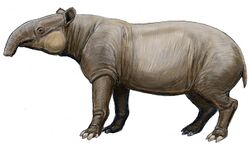Biology:Giant tapir
| Giant tapir Temporal range: Middle to Late Pleistocene
| |
|---|---|

| |
| Skeletal reconstruction of the holotype. | |
| Scientific classification | |
| Domain: | Eukaryota |
| Kingdom: | Animalia |
| Phylum: | Chordata |
| Class: | Mammalia |
| Order: | Perissodactyla |
| Family: | Tapiridae |
| Genus: | Tapirus |
| Species: | †T. augustus
|
| Binomial name | |
| †Tapirus augustus Matthew & Granger, 1923
| |
| Synonyms | |
| |
The giant tapir (Tapirus augustus)[1][2][3] is an extinct species of tapir that lived in southern China, Vietnam and Laos,[4] with reports suggesting it also lived in Taiwan,[5] Java, and potentially Borneo.[6] The species has been recorded from Middle and Late Pleistocene.[7] There is only weak evidence for a Holocene survival.[8] Tapirus augustus was larger than any living tapir,[1] with an estimated weight of about 623 kilograms (1,373 lb).[9] The species was also placed in its own genus of Megatapirus, however, it is now conventionally placed within Tapirus.
Discovery and taxonomy
Despite not being named until 1923, the Palaeontological Museum, Munich Paleontologist Max Schlosser described several teeth purchased from Chinese drug stores in 1903 that he assigned to Tapirus sinensis.[10] Some of the teeth had been unearthed at the Chang I locality in Wanzhou, Eastern Sichuan, China that come from the Pleistocene strata of the area.[10] Tapirus augustus was first described in 1923 William Diller Matthew and Walter Granger based on fossils found by the American Museum of Natural History during the Central Asiatic Expeditions of 1920–1930. The fossils had been recovered just a few miles from the site where many of the teeth described by Schlosser had been found.
References
- ↑ 1.0 1.1 Matthew, William Diller; Granger, Walter; Andrews, Roy Chapman (1923). "New fossil mammals from the Pliocene of Sze-chuan, China". Bulletin of the AMNH 48: 17.
- ↑ Janis, Christine M.; Scott, Kathleen M.; Jacobs, Louis L. (1998-05-28). Evolution of Tertiary Mammals of North America: Volume 1, Terrestrial Carnivores, Ungulates, and Ungulate Like Mammals. Cambridge University Press. ISBN 9780521355193. https://books.google.com/books?id=I-RgojcDyWYC&q=Megatapirus.
- ↑ "Fossilworks: Tapirus (Megatapirus) augustus". http://www.fossilworks.org/cgi-bin/bridge.pl?a=taxonInfo&taxon_no=192846.
- ↑ Louys, Julien; Curnoe, Darren; Tong, Haowen (January 2007). "Characteristics of Pleistocene megafauna extinctions in Southeast Asia". Palaeogeography, Palaeoclimatology, Palaeoecology 243 (1–2): 152–173. doi:10.1016/j.palaeo.2006.07.011. Bibcode: 2007PPP...243..152L. http://doc.rero.ch/record/16043/files/PAL_E3832.pdf.
- ↑ http://www2.ihp.sinica.edu.tw/file/3111QQPWEMU.pdf [bare URL PDF]
- ↑ Chazine, J.-M. (2005). "Rock art, burials, and habitations: Caves in East Kalimantan". Asian Perspectives 44 (1): 219–230. doi:10.1353/asi.2005.0006. https://core.ac.uk/download/pdf/5105503.pdf.
- ↑ Tong, Haowen (January 2005). "Dental characters of the Quaternary tapirs in China, their significance in classification and phylogenetic assessment". Geobios 38 (1): 139–150. doi:10.1016/j.geobios.2003.07.006. Bibcode: 2005Geobi..38..139T.
- ↑ Turvey, Samuel T.; Tong, Haowen; Stuart, Anthony J.; Lister, Adrian M. (September 2013). "Holocene survival of Late Pleistocene megafauna in China: a critical review of the evidence". Quaternary Science Reviews 76: 156–166. doi:10.1016/j.quascirev.2013.06.030. Bibcode: 2013QSRv...76..156T.
- ↑ Maclaren, Jamie A; Hulbert, Richard C; Wallace, Steven C; Nauwelaerts, Sandra (2018-10-05). "A morphometric analysis of the forelimb in the genus Tapirus (Perissodactyla: Tapiridae) reveals influences of habitat, phylogeny and size through time and across geographical space". Zoological Journal of the Linnean Society 184 (2): 499–515. doi:10.1093/zoolinnean/zly019.
- ↑ 10.0 10.1 Hooijer, D. A. (1947). On fossil and prehistoric remains of Tapirus from Java, Sumatra and China. Zoologische Mededelingen, 27(3), 253–299.
Wikidata ☰ Q309562 entry
 |


